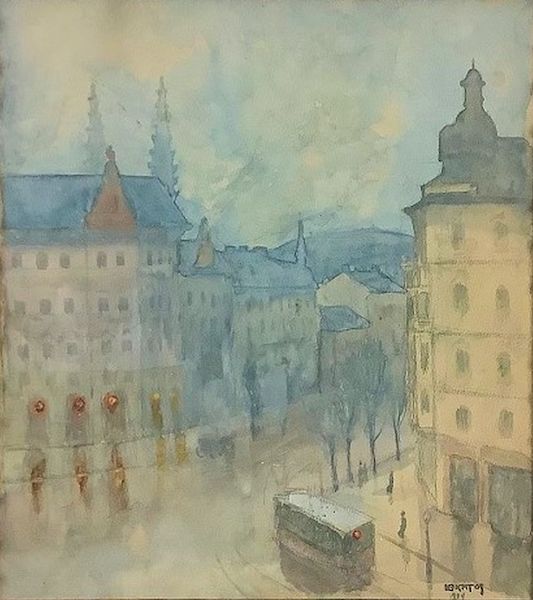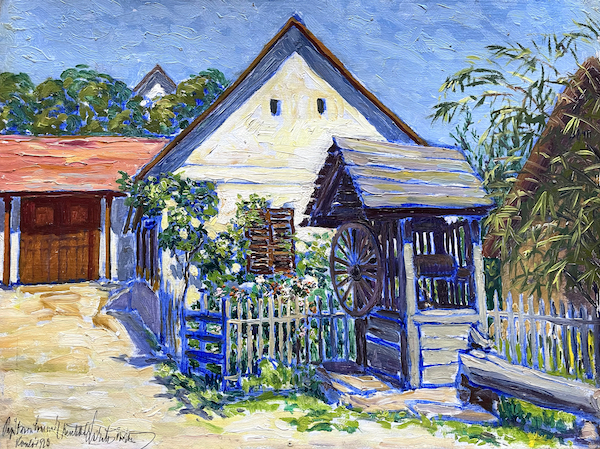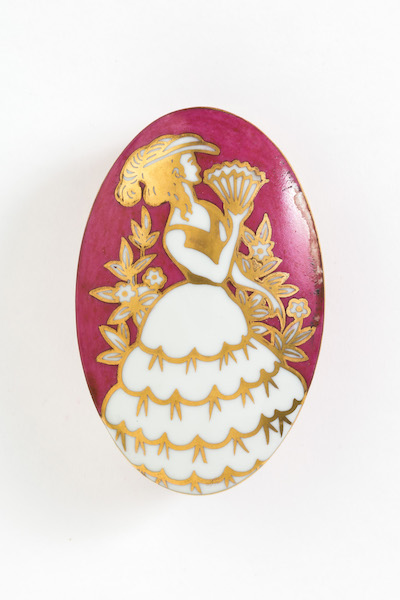Biography
Born as Artúr Schlosser, Hungarian painter and industrial artist. He completed his schooling at the Budapest School of Industrial Design, the Model Drawing School, and the College of Fine Arts, where he obtained a drawing teacher's certificate in 1905. He later studied with Bertalan Székely, attended Simon Hollósy's school in Nagybánya, then Munich and Paris.
His first book illustrations appeared in his friend Battlay Géza's book of poems. He published a number of headers and endnotes in the journal Művészet at the beginning of the last century. In 1905, on behalf of textile manufacturer Leo Goldberger, he studied large-scale artistic fabric production techniques in Mulhouse and Paris. In 1905, he won the first prize of 300 crowns at the knotted carpet competition of the Society of Applied Arts. The following year, he was chosen as a regular member of the Autumn Grand Salon in Paris, and at the International Exhibition of Applied Arts in Milan, his woven tapestry with the theme of Ilona the Fairy was awarded a gold medal.
He began his 35-year career as a teacher by organizing the weaving workshop of the Székesfőváros School of Industrial Design in 1906. During a four-year transitional period, he was a drawing teacher in the applied arts workshops of the Kassai State Correctional Institution (1908–1912). In the course of his work as an instructor-educator of a handicraft nature, he also had the opportunity to experimentally implement his own designs in the school's woodworking, weaving, and leather workshops. His work as a furniture designer unfolded in Kassa.
His first solo exhibition took place in 1910 in Budapest, in the Könyves Kálmán Szalon. At that time, he mainly presented himself as an industrial artist who also paints. In 1912, after settling back in Kassa, he took up his old position as the head teacher of the textile department of the Székesfőváros School of Industrial Design.
The First World War interrupted his successful career as an artist. He was forced to spend four years as a prisoner of war. The stations of his trial were: Serbia (Nis), Albania, Italy (Portoferraio on Elba Island, Azinara Island, Nocera Umbra Bagni), from December 1914 to March 1918. He returned home with seventy pictures painted in captivity, because his relatively humane captors allowed him to paint.
He held his second collection exhibition at the National Salon in Budapest in June 1918. The soldier-painter caused a great stir with his fresh impressions.
As a quality portrait and landscape painter of the László Paál Society, he participated in many group exhibitions between the two world wars. As a member of the Foreign Exhibition Organizers Committee of the Hungarian Ministry of Culture and Public Education, he organized many exhibitions. He designed many pavilions himself. In 1923, he won a painting prize at the Introductory Exhibition of the László Paál Society in the National Salon. In the same year, his knotted carpets were awarded a gold medal at the Monza International Exhibition of Applied Arts. In 1924, at the exhibition of the Society of Applied Arts in Vigado, he presented decorative porcelain objects. He created original ceramic designs for the Zsolnay porcelain factory in Pécs and the Fischer factory in Pest.
In the years 1926–1934, he created at the Százados úti artist colony. His wide-ranging design activities encompassed almost all branches of applied art. Individual drawings, book and newspaper illustrations, applied graphics, Ex Libris], furniture, interiors, paintings, textile designs, carpets, woven wall pictures, book boards, ceramic and porcelain objects, wallpaper designs and stained glass windows were exhibited from under his hand. He combined Art Nouveau with Hungarian motifs with an excellent sense of color and composition.
In 1931, at the Spring Exhibition of the National Salon, his paintings were awarded a silver medal (Pécs suburb, Ramsau). His third solo exhibition took place in Budapest at the Fészek Művészklub (1931). He regularly published articles on applied arts. In 1933, he wrote about the then International Fair in Hungarian Applied Arts.
In December 1935, at the Jubilee Exhibition of the National Hungarian Society of Applied Arts, he presented a Hungarian living room, furniture fabrics, carpets and other household items. His active participation in exhibitions was rewarded several times with the company's gold medal. In 1936, he created blueprints for the Herend Porcelain Factory (wave-contoured ashtrays, wall plates on the occasion of the 250th anniversary of the recapture of Budavar). He won a gold medal at the International Applied Arts Exhibition in Paris the following year. He retired in 1941, after thirty-five years of service as a teacher.
Even after the siege, he worked actively, creating in many genres of art: he painted landscapes, still lifes, and portraits; designed many colorful carpets. Once a week, he sent a picture to the jury of the Fine Arts Fund. He also appeared in exhibitions in the last two decades of his life (1945 - Ecclesiastical Art Exhibition, Szalmássy Gallery; 1948 - Exhibition of Social Democratic Artists, 1957 - Portrait Painters in the Ernst Museum, National Exhibition in the Műcsarnok, 1960 - The Art of Liberated Budapest, Hungarian National Gallery, 1962 - Nagybánya Painters , MNG, 1965 - Százados-úti Art Colony jubilee exhibition, MNG). His last jubilee exhibition was held in September 1960 in the Fényes Adolf hall in Budapest. He died at the age of 88, on February 9, 1968. Artúr Lakatos, the versatile artist, painted tirelessly until the last days.



